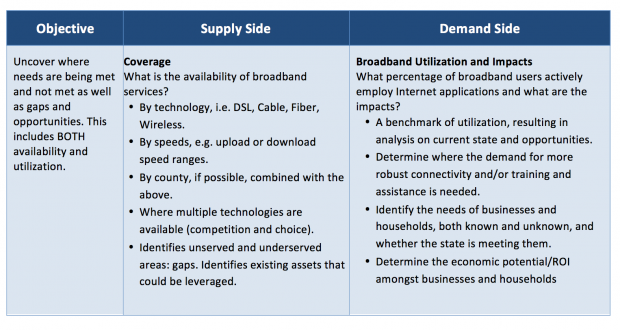Stop Blowing It: Taking a Holistic Approach to Broadband Planning
There is a misalignment between the broadband industry and developing strategies to meet community needs. The focus on the private sector business case to assess network return on investment has not incentivized community innovation, productivity, and competitiveness. Progress has been made, but the path has been reactive, not proactive. Broadband providers have failed to creatively engage a critical element in the broadband marketplace – the consumer.
 Broadband is a transformative technology, disrupting business as usual and fostering new products, processes and services. By examining two vastly different examples of technology (and their visionaries) that are changing our world we can identify a better path for the broadband marketplace to follow. Apple’s Steve Jobs’ often said it was foolish to depend on consumers to tell Apple what it wanted because “A lot of times, people don’t know what they want until you show it to them.” One hundred years earlier Henry Ford explained his mindset, “If I had asked people what they wanted, they would have said faster horses.” Both of these leaders were at the forefront of innovation not by simply reacting, but by proactively crafting products that would change consumers’ lives in ways the consumer had not imagined.
Broadband is a transformative technology, disrupting business as usual and fostering new products, processes and services. By examining two vastly different examples of technology (and their visionaries) that are changing our world we can identify a better path for the broadband marketplace to follow. Apple’s Steve Jobs’ often said it was foolish to depend on consumers to tell Apple what it wanted because “A lot of times, people don’t know what they want until you show it to them.” One hundred years earlier Henry Ford explained his mindset, “If I had asked people what they wanted, they would have said faster horses.” Both of these leaders were at the forefront of innovation not by simply reacting, but by proactively crafting products that would change consumers’ lives in ways the consumer had not imagined.
Meanwhile, in the broadband marketplace we are blowing it. Instead of understanding BOTH supply and demand, instead of taking the time to be proactive, broadband ‘planning’ often takes a reactive path that simply addresses availability challenges. A more proactive approach includes consumer demand, now and what it may become. Ford and Jobs based their product design on potential demand, not just current demand. They also took steps to drive demand as many consumers don’t know the potential value of the product or service (the innovation). The gap between current demand and potential demand is the innovation gap.
Planning for broadband demand is more than just availability, historic ‘take rates’ (current demand), and average revenue per user (ARPU) – which is a supplier viewpoint. Broadband demand assessment should be consumer centric, capturing how individual businesses, organizations, and households could use broadband along with how they currently understand the relevance and potential benefits of available Internet applications and Internet connectivity. For example, demand for broadband by businesses is a function of how each individual business understands which Internet applications they could and should be using to be competitive, as well as understanding how each drives new revenues and/or cost savings. Some consumers understand the relevance and benefits of what they can and should be doing online while many do not. Uncovering current and potential demand helps us plan for today, meet the broadband needs of tomorrow, and do so in a manner that is fiscally sound.
Without understanding demand, current and potential, we are painting ourselves into a corner where the only acceptable outcome is building fiber, everywhere. For most communities, that’s just not financially feasible and possibly not even necessary. Furthermore, only addressing broadband availability does not address gaps in innovation and competitiveness. Every community is unique and the plans that guide them forward need to be tailored to their specific challenges and potential, both on an infrastructure and human level. Not only do we need to maximize community benefits with what is available now, but also what will be needed going forward to thrive in a digital economy. The current broadband planning paradigm needs to change.
SNG is taking our own steps to do just that. From working at local, regional, and federal levels we have developed both quantitative and qualitative measures of the actual and potential impacts from using broadband. These measures provide the data to inform smarter investments and help set priorities which are critical for broadband planning that increases local economic competitiveness and quality of life.
SNG is helping our clients effectively drive availability, social outcomes, and economic development through broadband with this holistic approach. We are forging partnerships to expand our broadband data collection and use this information to deliver broadband plans that are customized, comprehensive and strategic in addressing both supply and demand. We have already delivered on this approach with the State of Tennessee, measuring both supply and demand statewide to uncover innovation gaps and opportunities to drive economic development through broadband (see the Tennessee Report). Our approach enables communities to develop customized and realistic broadband development plans.
As the number of applications and services delivered over the Internet grows a holistic approach ensures that planners and leaders understand existing gaps, barriers to adoption, and best practice strategies to build potential demand and capture the full benefits from broadband investments.

Broadband infrastructure and the capacity to use it are critical to innovation, economic competitiveness and community development at every level. Communities large and small, rural and urban need a holistic strategic approach to grow business and support a high quality of life.
To learn more about how taking a holistic approach to broadband planning can help your community, contact SNG.



